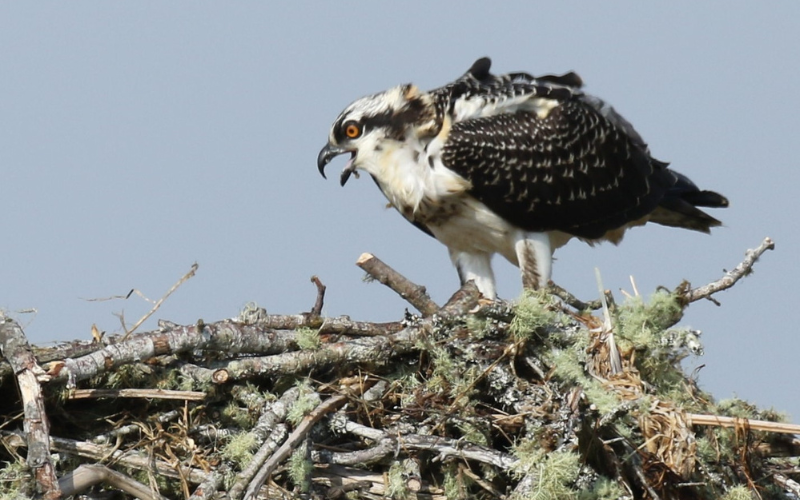
This year’s only young osprey at the Reed Ranch nest site.
In early August, nature photographer, biologist and naturalist Neal Maine had a chance to check up on the family of ospreys who reside parttime at North Coast Land Conservancy’s Reed Ranch Habitat Reserve.
The osprey nest at this reserve rests on a pole that Pacific Power built a few years ago to relocate the ospreys from a nearby power pole.
This summer, there was only a single chick in the family at Reed Ranch—which is not a publicly accessible habitat reserve. On average, ospreys tend to have two or three chicks per year, although several variables can influence how many eggs are hatched and the survival of chicks, Neal says.
Ospreys mate for life. As part of their annual cycle, they start building their nests in the springtime. Generally, the male will do the bulk of bringing sticks and tufts of moss as part of the couple’s courtship, Neal says. The species as a whole is “religious about returning to their nesting site” from previous years.
“Then they spend a bit of time at the beginning of the season warding off other interested ospreys,” he adds
The female typically lays her eggs in mid-April and there is an incubation period of roughly 35 to 42 days. Osprey chicks will generally start to hatch around the end of May or the beginning of June.
At this time of year—near the end of August and beginning of September—ospreys on the Oregon Coast are preparing to migrate south.
“We haven’t seen any wintering birds around here,” Neal says. “You kind of just wake up one day, and they’re gone. No osprey anywhere.”

The adult female at the Reed Ranch nest site likes to hang out on this power pole a lot.
One of the characteristics of the osprey that Neal appreciates is their ability to spot and catch fish from truly great heights.
A significant portion of their diet consists of flounder. Neal points out how these fish are even difficult to spot to the naked human eye from a few feet above ground.
Meanwhile, “the osprey is flying around 100 feet above the water and spots the flounder,” Neal says. “They spot it and bring back flounder after flounder to the nest. It’s totally baffling. Do they have x-ray vision or what? It’s like a small miracle every time I see an osprey with a flounder.”
“We have a way of measuring everything by our own capacities to see, to smell, all those things, but nature has made adjustments for other creatures,” he says, adding he is constantly in awe of the different “miracle capacities” possessed by other living creatures. “They have some superpowers in many of those areas.”
What do ospreys sound like? Listen here!
Comments